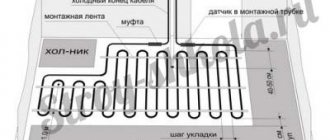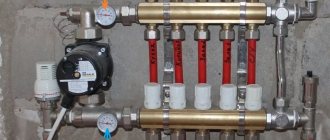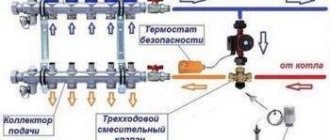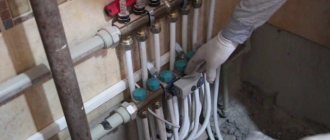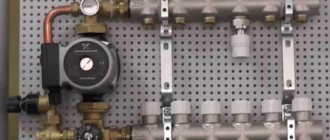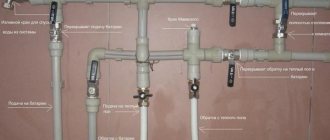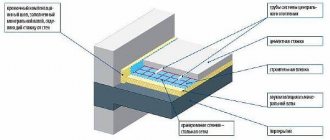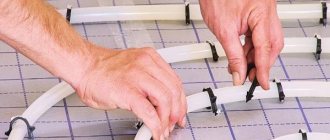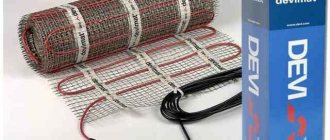Installing the regulator: the need to use the device
The temperature sensor is a guarantee of uninterrupted operation of the heated floor without overheating and early failure. Despite the fact that a water heated floor can work without a sensor (if there is no equipment in the project being laid), installation of the equipment will allow you to change the heating level, which, you see, is quite useful during certain seasonal weather changes. In addition, systems with liquid coolants, where the device regulates the operation of a three-way valve and/or circulation pump, are able to heat up to the desired temperature without depending on the temperature conditions of the coolant.
How does automation work?
A thermostatic three-way valve for underfloor heating is connected in front of the manifold. A certain temperature heating mode is set on the sensor. The device starts working when the parameters are changed.
- The device consists of a semiconductor, which has the temperature of the coolant entering the line. Energy is transferred to the thermostat fluid.
- As the heat increases, the liquid expands and puts pressure on the rod, which lowers.
- In this case, the outlet from the hot pipe is closed and the outlet from the return circuit is opened.
- The cooled coolant enters the three-way mixer chamber, where it is combined with hot water from the boiler. The mixing process can take place according to a T-shaped pattern: hot and cold coolant flow enters the thermostatic mixing valve symmetrically from both sides. The liquid exits into the main line at an angle of 900. With an L-shaped design, hot water enters the mixing chamber from the side.
- The coolant temperature decreases. It enters the floor line cooled. The heating mode strives to reach the set norm.
- As the temperature drops, the liquid in the thermostat contracts. The spring-loaded rod straightens, closing the outlet of cold water that flows through the return pipe. Hot coolant again enters the main line.
When using servo drives, a device that operates from the network is connected to the mixing valve for heated floors. The sensor heats up and closes the electrical circuit. The plate is heated, which in turn transfers heat to the thermal fluid. It expands, pressing on the rod, which makes the poppet valves work.
We recommend: What are the advantages of Gulfstream underfloor heating?
When using a servo drive, the heating system changes operating mode within 3 minutes. If you use a thermal head as an automatic device, it will take up to 15 minutes to heat the liquid in the thermostat.
The operating principle of a two-way valve for underfloor heating is somewhat different. When the temperature in the main increases, the thermostat causes poppet valves or a ball device to operate, which completely blocks the outlet for hot water. The cooled coolant from the return pipe returns to the floor circuit.
When the temperature decreases, the valve opens hot water and closes the return flow. There is no mixing of the liquid. The principle of operation of a two-way thermostatic valve for underfloor heating is identical to manual switching of valves, but the system operates in automatic mode.
A three-way thermostatic valve for underfloor heating is installed in a heating system for a large heating area. The equipment is necessary for a boiler that heats water to a high temperature. A two-way valve is connected to the system as additional heating control for individual rooms.
Equipment for automatic control of the heating mode can be installed in a single-circuit or double-circuit heating system. This is convenient when using various types of heating, radiator and floor. The mixer is connected before the circulation pump. I recommend installing a water filter first. When connecting, use the threaded installation method.
Types and types of sensors
Remote electric sensor for adjusting floor temperature
All sensors and regulators can be divided into two types:
- The mechanical device has an operating principle based on the property of changing volume depending on temperature readings.
- Electronic, installed remote sensor in the form of a thermistor. It is supplemented by a separate control unit containing an electronic circuit, operating order and indication elements.
Devices are also divided by type:
- a device operating in economy mode, which allows you to reduce the level of floor heating in the room when there are no people;
- sensors with a timer, which have a program for turning on/off the heating system;
- intelligent sensors with a built-in operating algorithm and control of other factors: humidity conditions, temperature fluctuations outside the room, presence/absence of people in the room, etc.;
- limiters are thermal devices that turn off the heating of the coolant when a predetermined temperature is reached.
Advice! In simple heating systems, the presence of highly intelligent sensors is less justified than connecting a conventional electronic regulator. Numerous functions of the devices will not be in demand, for example, in warm water floors.
Example of a mechanical sensor with a temperature element
Thermostats for water heated floors differ in the type of monitored environment:
- floor temperature control;
- control of the degree of air heating.
As a rule, sensors for determining air temperature are located in the thermostat housing. This provides additional convenience, since no unnecessary installation problems are foreseen; on the other hand, the installation of the thermostat must meet a number of conditions:
- absence of nearby sources of heat/cold;
- There is no threat of direct sunlight or draft blowing.
Important! The installation location of the device is selected taking into account the accuracy of the temperature display, so it is best to place the equipment at a height of at least 1-1.5 m from the floor.
The water floor system can be supplemented with a remote temperature sensor. Representing a small-format device attached to the end of a long cable, the measuring device is mounted in the floor with a distance of 0.5 meters from the wall. The placement is shown at a distance equidistant from the nearest coolant pipes. The second end of the structure is connected to a temperature sensor and attached to the terminals according to the diagram.
Where are the most expensive new buildings in the Moscow region?
Advice! This type of device must be installed during pipe laying before pouring the concrete mixture. It happens that such devices fail, so it would be useful to provide for the possibility of replacement by laying a corrugated hose.
Equipment characteristics
The coolant from the boiler passes through the pipe line to the collector. From it the liquid flows into the floor pipeline. Giving up heat, it returns back to the collector, which has a separate return outlet for the cooled coolant. The circulation pump forces water back into the boiler.
When manually controlling the temperature regime, valves are installed on the circuit with cold water and high-temperature coolant. If the room has warmed up well enough, then the hot water valve is closed. If the room is cold, the valve is opened.
To automatically regulate the heating mode, install a three-way mixer with a thermostat and an external temperature sensor. This system forms a thermostatic valve. It is installed at the entrance to the collector. The equipment is made of brass or bronze.
- The three-way valve has 3 outlets for hot, cold water and coolant, which is supplied to the floor line. Markers on the body indicate the direction of flows of different temperatures.
- A mixing chamber is provided to mix liquids of different temperatures.
- On the body there is a thermostat with a temperature regulator.
- The temperature sensor is located on the thermostat.
- The valves close the outlets for cold and hot flow. They can be disc-shaped or needle-shaped. Their operation depends on the thermostat.
- The thermostat is a system that consists of a capsule with liquid and a spring-loaded rod. Valves are attached to it.
- The temperature sensor has a digital panel on which the heating modes are indicated.
We recommend: Instructions for laying heated floors
The thermostat can be located in the thermal head or in the servo drive. The devices have different circuits, but the same principle of operation. The thermal head is a thermostat, the operation of which is carried out using a liquid: it is sensitive to temperature changes.
Servo drives operate from the electrical network. The liquid is contained in a container. It contains a heating plate. The servo drive is installed on the manifold.
The three-way mixer is designed for heating systems of large areas. In separate rooms or in country houses, a two-way valve is connected to the collector. It is installed on a circuit with a high temperature coolant. Water flows through it in only one direction.
Connection diagram for a heated water floor thermostat
Connection diagram of thermostats to a manifold with a servomotor.
This design does not require the installation of the device, such as, for example, electric floors. In the case when the boiler is not powered by electricity, there will be no large financial costs with little optimization of heating operation.
There is an option for adjustment in the usual manual way, based on subjective preferences, but only if the floor is the only heating device and the boiler does not raise the temperature above +50 degrees. But if there are other heaters in the house (in the system): radiators, a hot water circuit, a thermostat for a water floor, installation is required.
The simplest connection diagram is to install a thermostatic head with a remote-type sensor on a two-way valve. In this case, the head filled with a heat-sensitive substance will instantly respond to any changes: when heated, the substance will expand, and when cooled, it will contract, thereby opening or closing the coolant supply.
Advice! For a large house with several branches of the heating system, it is preferable to install several temperature sensors with servo drives.
Connection diagram for a thermostat for a water floor:
- the servo drive is mounted on the return comb of the manifold for a warm water floor;
- wires are pulled from the collector to the regulator device, equipped with an air temperature indicator;
- the distributor box for the drive and thermostat is located in the manifold cabinet at a level above the combs;
- the cable from the distribution box goes to the distribution panel.
Electric servo for water floor temperature control
What are water floor servos? These are devices without which it is not possible to regulate the temperature of the liquid water coolant. Representing small-format electrothermal devices that open/close the media supply, servos operate through a bellows - a cylinder filled with a substance that has the ability to change volume under the influence of temperature.
Today, manufacturers offer two types of servos: open and closed. Valve Position Difference:
- in open designs the valve is open until the heating/cooling signal appears (at which it closes),
- in closed - the valve is normally closed until a signal appears at which it opens.
The choice depends on the user’s preferences, however, experts recommend open-type servomotors due to the fact that even in the event of a breakdown, the water in the system will continue to function and the floors will not freeze.
Electric and water heated floors: scope, design diagrams and calculations
Important! When choosing servos with a 24V DC voltage supply, you will need to install an inverter.
Connecting the servo drive is not difficult. Depending on the type of thermostat, it is possible to connect:
- if there is a thermostat that controls a single floor heating circuit, installation is carried out with the appropriate wires;
- if the device is multi-zone type, the wires are connected to the corresponding terminals.
Thus, servo drives perform not only the role of passing/closing the coolant, but also a protective function. The closed position signals the end of pump operation, which will extend the life of all equipment - the pump will not run idle, which means the risk of system failure due to increased pressure will be minimized.
Important! In underfloor heating systems, the pumps of which are of the usual solid fuel type, turning off the pump is unacceptable: the boiler will not go out anyway, and stopping the functioning of the system (signaling) threatens to rupture the entire structure. Installing a bypass and bypass valve will avoid this situation.
Part Description
Valve design
Three-way thermostatic valves are installed in underfloor heating systems to mix coolant flows. When the supply and return flows enter the valve cavity, water with different temperatures is mixed, and its temperature is equalized. In other words, this part is designed to ensure that neither too cold nor too hot water gets into the water-heated floor pipe system.
Mounting unit for thermal head to valve
The main parts that ensure the operation of this device include:
- Thermal head. This element is a functional block that is mounted on the valve stem through a special axle box. During operation, the thermal head reacts to the air temperature, changing the position of the valve axle box and regulating the degree of heating of the coolant at the outlet.
- The main part of the thermal head is a temperature sensor, which reads the temperature and, through a system of capillaries, transmits control signals to the device drive. Depending on the sensor readings, the actuator either opens or closes the valve.
Note! For correct operation, it is necessary that the thermal head be located in a horizontal position. Therefore, the valve itself must be installed taking this requirement into account.
- Most thermoelements used in the design of heated floors operate on the basis of corrugated containers - the so-called bellows. The bellows is filled with gas, which reacts to changes in air temperature. The temperature deformation of the bellows is transmitted to the axlebox rod, and it either increases or decreases the flow of hot water.
Three-way valve with thermal head
- In addition to gas valves, liquid and paraffin thermal valves are also used today. They are distinguished by a slightly lower price, however, such devices react more slowly to changes in heating and are therefore characterized by significant inertia.
- In some cases, when constructing a heated floor, a thermoelement with a remote cylinder is used. The cylinder is connected to the bellows by a capillary up to 2 m long, while the principle of operation of the device remains unchanged.
Note! Thermoelements responsible for the operation of underfloor heating valves have limitations in setting the temperature. As a rule, adjustment from 20 to 400C is possible.
Mechanical system
Mechanical section
In addition to the thermoelement that regulates the operation of the device, the design of this part includes:
- Valve body . As a rule, it is made from high-strength metal (stainless steel, cast bronze), which is resistant to corrosion. A head with a thermoelement, as well as pipes for the inlet and outlet of coolant, are fixed to the body.
- Buksa . Responsible for locking the entrance to the thermal head connection unit and connects the rod to the spool. Some companies produce specially shaped axle boxes that allow you to replace the thermoelement without draining water from the system.
- The valve seat is the internal cavity in which water is mixed.
Complete device
Adjusting the heated floor temperature
Scheme for adjusting the temperature in the system using a servo drive.
The simplest adjustment option is with manual taps. A slightly more comfortable option is automatic thermostats with sensors and servos, but only with the additional installation of a restart valve and switching unit. In addition, there are other ways to regulate the heating of floor water systems:
- change in coolant flow;
- change in coolant temperature.
The second method is used especially often and involves the installation of a three-way valve, which is entrusted with the function of controlling the mixing unit. The relay output of the temperature sensor is connected to the solenoid of the electric shut-off device: at the slightest excess of the temperature of the value set in advance, the valve opens, causing the cooled water to mix with the incoming liquid, reducing the heat capacity.
Thermal head for heated floors: installing a three-way valve
A thermal head for underfloor heating is installed in the heating system so that the temperature in the room is maintained at a given level. A comfortable temperature is considered to be 20°C at a height of 1.5 - 2 m, with a floor covering temperature of 22 - 24°C.
The placement of the heating element along the entire horizontal plane of the floors allows for uniform heating of the air in the room.
Adjustment mechanism
Thermostatic mixing valve
A thermostatic mixing valve is also used in radiator-type heating schemes, but convective air circulation (even with balanced ventilation and careful insulation) still leaves the lower layers as the coldest part of the room.
The source of thermal energy can be either a central heating plant or an autonomous boiler. In any case, boilers operate effectively in stable modes and will not provide smooth adjustment of coolant flow in each individual room.
For this purpose, special fittings with selected operating parameters and a specific type of design are included in the system. Installing a mixing valve for underfloor heating gives the following stabilizing result in normalizing the temperature in the house:
Mixing valves perform the task of combining a high-temperature heating circuit with a low-temperature underfloor heating distribution, since the recommended temperature in the pipes under the floor is 40°C, and for the water leaving the boiler 70 - 90°C.
Work principles
If the coolant is too hot, a cold stream is mixed into the water
The three-way valve for heated floors performs its function in the following order:
- the hot coolant from the boiler is directed to the distribution manifold, from which it diverges through the loops of the underfloor heating system;
- a thermo-mixing valve is installed along the path of movement, reacting to the heating temperature of the water;
- when the flow temperature exceeds the set value on the regulator, the latter opens a passage for mixing cooled water from the return pipeline;
- in the tee, two converging flows are mixed and the coolant of the desired temperature is released into the system;
- When balance is achieved, the change in the internal sections of the valve stops.
The valve body is made of brass and consists of 3 channels converging to the adjustment mechanism. The use of 3 different methods of mixing water flows distinguishes 3 types of three-way valve designs.
Three way thermostat
The thermostat mixes hot and cold flow
The set temperature is maintained by a three-way thermostatic valve, which automatically mixes the hot liquid flow from the heater and cooled water from the return pipeline. The need for quantitative changes in flows is determined by the thermostat settings.
This product can be used in underfloor heating systems (especially complex configurations), on radiator wiring and in the internal hot water supply circuit.
Automatic change in the temperature of the outgoing coolant protects a person from elevated temperatures in the event of a pipe rupture. If for some reason the flow of cold water stops, the valve will automatically close the flow of hot pressure from the boiler. The temperature-sensitive unit responds to the amount of heating and, accordingly, changes the cross-section of the inlet holes, achieving the required balance.
The layout of the thermostatic valve for a heated floor looks like this:
A pressure throttle is a device that provides fluid pressure regardless of the pressure difference at the inlet and outlet. Paired with a thermal head for a heated floor, it stabilizes the operation of all system circuits when incoming conditions change.
3-way thermostatic valve
The operation of this valve is not as complicated as a thermostat. Only the incoming hot media is regulated. For more information about the operation of three-way valves, watch this video:
To analyze changes in temperature indicators, the kit includes a thermal head for heated floors, which acts as an executive body based on a signal from an external sensor.
Mixing valve
Manual valve adjusted manually
The three-way mixing valve, which is not equipped with sensors and automation, is even simpler. The manual valve needs to be forced to set the position of the regulator to obtain the desired outlet temperature.
This crane is manufactured in 2 types:
- has a T-shaped passage (symmetrical design);
- internal L-shaped passage, (asymmetrical).
The differences are that with a symmetrical scheme, 2 jets meet from opposite arms of the valve and go into the side branch already in a mixed state.
In the asymmetrical version, cold water rises from below, the hot stream approaches from the side, and the mixed medium leaves in the direction of the hot one.
Reasons for selection
Three main conditions should be taken into account when choosing the type of control valve:
- Room area. The larger the cubic capacity of the room that requires heating, the more difficult and often it is necessary to make adjustments, so it is necessary to install automation here.
- Pipe section. The valve passage must be no less than the pipe Ø. If it is larger, then an adapter is placed on the smaller pipe.
- Maximum flow (throughput). The characteristic is set when designing a heated floor.
If floor heating is carried out in small rooms with an area of up to 10 m² and is not the main heating system in the house, then coolant can be supplied to the circuit through 2-way taps. Such a device will automatically supply the required portions of hot water to the connected loop, maintaining the desired temperature.
Source: https://gurupola.ru/teplye-poly/termogolovka.html
Advice from professionals
In order for the water floor to work flawlessly and the installation of the thermostat to go perfectly, it is worth taking note of some installation subtleties:
- the presence of a normal cross-section of the thermostat cable is welcome;
- if the wiring in the house is old, it will be safer to install a separate line (when connecting a boiler powered by electricity);
- a regulator installed to control several water floor systems is not entirely convenient, since adjustment will only be available in the room where it is installed;
- You cannot use a single temperature sensor if the operating conditions in different rooms are different.
Connecting a thermostat to a water heated floor system yourself will not cause much trouble. It is enough to choose a device that meets all the requirements, carefully review the step-by-step work and enjoy the warmth and comfort of your own home.
How to choose a thermostat for water heated floors
A water heated floor is a concrete screed in which a circuit of heating elements is poured. In this case, the circuit means a pipe through which hot water moves. The coolant is supplied from the heating system and returned to it.
Installation of the circuit can be carried out both in the screed layer and on top of it. Both options have their advantages. But most often, builders prefer to relieve the horizontal water heating system from the physical load of the screed.
The operating principle is cyclical. First, water flows from the heating radiator to the beginning of the heated floor and, passing along the contour, gives off its heat to the surface of the screed. After this, the coolant returns to the central heating and is reheated in order to pass through the circuit again.
The elementary principle of operation and minimal electricity costs make this type of heating extremely popular. Cycling thus allows the screed to warm up to 36 degrees.
Installation involves its own difficulties and algorithm. One of the most important aspects is the installation of a limiter if the final floor covering is laminate or linoleum. These floor coverings should not heat above 27 degrees. A temperature regulator (thermostat) allows you to adjust the “climate” in the house with an accuracy of a degree, so its presence is mandatory.
Meaning and functions
A thermostat is a device that is designed to control temperature conditions. This device determines the temperature at a given time and compares it with the default value. Thus, the thermostat either turns on the heating in order to reach the desired temperature, or, on the contrary, turns it off if the indicator is reached.
In the case of a water heated floor specifically, the thermostat performs its functions in stages. Using servo drives, this device gives the command to slightly open or, conversely, partially shut off the supply of hot water from the central heating. Such control allows the floor to maintain a certain degree of “warmth”.
If an electric heated floor is able to heat up to the desired level in a matter of minutes, then a water floor, due to the consistent operation of the regulator, completes its task in a longer amount of time.
A thermostat for a water heated floor is an indispensable attribute and, thanks to its advantages, there is no doubt about its necessity:
After installation, you will need to understand the control method and some nuances. In order to get comfortable with this issue, you only need to spend time once understanding the keys and menu of the thermostat.
Types of thermostats
On the modern market you can see a whole range of thermostats, which can be divided into four types:
Mechanical devices resemble dimmers - lighting controllers. Control occurs using a single wheel. As you rotate clockwise, the device turns on and is adjusted to maintain a certain degree. The cost of such devices is the lowest when compared with other varieties. They do not have a shutdown function when the required temperature is reached, and this is a significant disadvantage. Despite this, the device performs the monitoring function properly.
The digital analogue has a screen with which you can adjust the temperature with an accuracy of a degree. There is a temporary shutdown function. Control is carried out by three keys. Most of these devices have a memory function that allows you to save the settings even after a power outage.
Software thermostats or programmers appeared relatively recently. With their help, you can create a complete operating schedule for the heated floor. Thanks to the time setting, you can specify the exact time when water supply from the heating system starts and stops. Thanks to this function, the floor will heat the room only during those hours when household members are at home. This is a huge energy saving. The cost of such a device is high, but during operation it inevitably pays off in electricity bills.
The touch thermostat can be called an innovative invention in this area. It has all the functions of a programmer, but is controlled using a touch screen. The ease of setup is undeniable, but due to the sensor, the cost of such a device is quite impressive.
The thermostat is a necessary component of a water heated floor, which is not easy to do without. Thanks to the range of devices, you can choose the most optimal option.
Basic information about the thermostat for heated floors
The system, in addition to the thermostat itself, includes a special temperature sensor. Installation of the second device is carried out using a corrugated plastic tube. This product is located in the floor screed.
Temperature sensor
The temperature sensor must be mounted in a corrugated tube
Modern thermostats have the ability to be programmed, which is very convenient. For example, the owner can configure the device in such a way that, in the absence of the owners, the heated floor will operate in energy saving mode, and some time before people arrive home, it will switch to full heating mode, ensuring the desired temperature in the room being served.
Regulators with a programming function are somewhat more expensive compared to their “brothers” without this feature, however, due to savings on the consumption of the heat source, the difference in price is compensated for on average in 1-3 seasons.
Thermo thermostat for underfloor heating Thermo Thermoreg TI 900 programmable
A classic version of a room thermostat for heated floors with a remote temperature sensor
Thermostat ELECTROLUX ETA-16


